It’s the journey, not the destination
Out in the mountains, there are some contingencies that one just cannot plan.

Our dream was to trek to the Hushe village, beyond Gondogoro La — which at a towering 5,940 metres is one of the world’s highest mountain passes — and we chose the most unconventional route to do so.
True to the spirit of people possessed by their dreams, we treaded the path less travelled that would take us to the pass in the shortest possible time. It took us seven days via Skardu, instead of the usual 10 days via the Concordia route, to reach our destination. It is the point where we would be able to get a view of the second-highest point on earth — the magnificent K2 — which is not visible from any other point.

The road to one’s dreams is never easy and it took us one full year to plan out ours. Most of our colleagues from the trekking community told us not to do it. They said their apprehension came from our choice of route but we could tell that that wasn’t their only worry: a woman was heading the trek and most of them considered that to be a disadvantage to the team. Little did they know that having a woman leader is a blessing, because our leader did not feel the need to go ahead with something potentially dangerous just to prove a point and would think every decision through. As thrilling as it is, trekking can also be life-threatening and the kind of leader in whose hands you would want to put your life, should be one who doesn’t believe in unnecessary risks.
In July 2011, our group of four was ready to go. We chalked out our daring plan for the next seven days, gathered our resources, pulled up our socks and, anti-climactically, ended up taking a detour!
We could have taken a 55-minute plane ride from Islamabad to Skardu instead of wasting a-day-and-a-half on the Karakoram Highway but thanks to Pakistan International Airlines, the only airline that flies to Skardu, the flight was cancelled and we ended up going by road.

Already a little behind on our schedule, we decided to relax our muscles for a day in Skardu, where the 1,982-metre height difference from Islamabad was a welcome change. We were in for some serious physical exhaustion in the coming days so we thought it best to get some rest.
With mounds of luggage packed and loaded on to jeeps, the four of us and our guides and porters set off for Hushe, the highest valley of the Ghangche district of northern Pakistan at 3,050 metres, located 140 kilometres east of Skardu.
We were the only Pakistani group headed in the other direction on Askoly Road that leads to Askoly and then, through the Baltoro Glacier, onto Concordia, where four of the world’s 14 ‘Eight-thousanders’ (peaks higher than 8,000m) are located.
We were close to both our destinations now — the Gondogoro La, which connected Concordia and upper Baltoro to Hushe valley, and then the valley itself.
Enroute to Hushe, we drove through sand dunes and crossed the Shigar valley to enter Khaplu, which used to be a geographically significant kingdom of Polulu in ancient times. Our jeeps climbed up to 3,250m that day via Kande and Nangma valleys (notable for Amin Brakk and Iqbal Top) and dropped us to the ever-smiling Hushe village which is the home to Masherbrum, the world’s 22nd highest peak.

The next morning we finally began the trek that had taken such extensive planning. Taking in the glorious views of the “Queen of the Peaks” Mount Masherbrun (K1), we reached a point known as Saitcho (3,600m) which is a sort-of base camp for the Hushe Valley trek.
At Saitcho, we saw the breathtaking Namika (6,325m) and Baltistan K6 (7,292m) and K7 (6,934m) peaks of Hushe and Shyok valleys and the Masherbrum mountains. From here on, we hiked continuously to Gondogoro campsite (3,853m) and Golong under the shadows of Masherbrum.

Then we faced a steep descent to what is known as the Gondogoro Glacier. There were no footsteps from previous trespassers, which is not surprising given that there is no trail at all. Carefully, we scrambled through the glacial surface, fighting fears of continuous rock falls. It took us 35 minutes to cross the glacier and another hour to reach the lush green campsite of “Field of Flowers” Dalsangpa (4,150m).
Close by stood the Masherbrum Pass, notorious for being so difficult that it has been climbed only a couple of times. If there were questions in our minds about why the pass had such a reputation, the two to three roars of avalanches we heard along the pass during our overnight stay answered them all.
Thankfully, we did not have to cross the pass, and that thought probably helped us sleep for a few hours without too many nightmares.
From Dalsangpa onwards, one begins to easily feel the “paranoia of 4,000 m” and all of us were feeling that when we restarted our trek at 4 am the next day. It was still quite dark and it set the stage for the next two-and-a-half-days when we didn’t see any sun at all.

The further we hiked, along with the sunlight all colours deserted us as well. We had stepped into the kingdom of wilderness, emptiness and rock-ice. There were glaciers everywhere with the Masherbrum Pass in the background. We kept on walking, tripping and slipping on our way, across the moraine and glacial debris.
It felt as if the temperature was falling with every metre we walked and the icy haze just kept becoming more and more dense, forcing us to put on all our layers of inner and outerwear. We were amazed at the drop in temperature, as our research had shown that the area does not experience such extreme weather during the month of July.
After crossing many a hidden crevasse and jumping over wide glacial spaces, we were ready to take a break and treated ourselves to our life’s most expensive 1.5-litre bottle of Coke. Yes, Coke is available in the middle of the mountains — albeit at a whopping price of Rs735 and that too for an expired one — at a small shop of the rescue team. Pressed for an option, as all other available drinks were expired as well, we paid up.
As we moved towards Khuspang, the gorgeous Laila Peak was in the background. During normal weather conditions, the peak can be viewed easily, but given the harsh climate we were facing, every rock that we tried to lean against to relax and take in the view was too frozen to allow us even a moment of rest. The continuous rain wasn’t helping our cause either. Eventually, robed like Eskimos and with aching limbs, we finally found our way to the Khuspang campsite.
Khuspang, which is the last camping ground before the gateway to Concordia known as the “Throne Room of the Mountain Gods”, was covered in pitch-dark clouds and thick mist. By evening, raindrops had transformed into bits of snow and the temperature, which had remained consistently cold until then, dropped suddenly to -14 degrees Celsius. Given the extremely low temperature, we decided to stop laughing, talking, eating or even moving around too much because any air that we exhaled would turn into snow powder almost instantly!
The next day, however, we woke up determined to acclimatise ourselves to the altitude and weather conditions regardless of how severe they got. Our plan was to leave Khuspang at 9 pm and, over the next 10 to 12 hours, hike up roughly 1,200m to the top of Gondogoro La.
Our technical gear, like crampons, was out and being fixed onto our boots. But all of us were quite worried about the drastically changing weather conditions. Visibility was zero and it was tough to see any of the high mountains surrounding Khuspang. Given the conditions, we even wondered if we should we postpone our plan.
To arrive at a final decision, we approached a member of the Gondogoro Rescue Team who updated us through radio communication that due to the bad weather, a team attempting the Gondogoro La trek from the Concordian side via the Ali Camp had gotten stuck some hours ago. It was nearly impossible even to attempt Gondogoro La from either side, he told us.
Slightly discouraged, we decided that we would make another attempt only if the weather would be clear the next day. Hoping to get some sleep, we played Kishore Kumar’s timeless “Jeevan ke din chotay sahi” to drown out the scary sound of avalanches.
Luck, however, was not on our side and we were in for an unpleasant surprise the next morning. As we expectantly unzipped our tents and looked out, we were stunned to see that the campsite was completely inundated with snow almost a foot deep. In that pristine view of white everywhere, we saw nature in all its ferocity; Laila Peak was veiled in white and Fairy Castle Peak hid itself in a patch of dark clouds.
Never in history had Khuspang experienced such heavy snowfall in the peak of the summer season and no trekker whose account is available has ever seen Khuspang covered in snow. For us, however, it was the last nail in the coffin for our plans of trekking towards Gondogoro La as the weather reports for the next few days were even worse.
With heavy hearts, we bade goodbye to the one that had haunted our dreams for many a nights. Our wish to see K2 from atop the Gondogoro La would have to be fulfilled another time, and in that failure, we felt the divine presence and bowed our heads. Each one of us was having a personal conversation with God.
If the farewell ritual was emotional, the return to Hushe was even more dramatic. Covering almost two stages a day, we returned to Skardu and proved that the human body might have its limitations but the human spirit is invincible. We had learnt that courage doesn’t always roar; sometimes courage is the quiet voice at the end of the day saying, “I will try again tomorrow”.
Published in The Express Tribune, Sunday Magazine, December 9th, 2012.
Like Express Tribune Magazine on Facebook and follow at @ETribuneMag



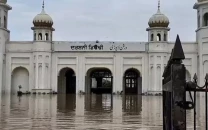
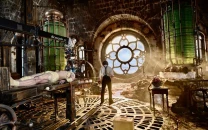

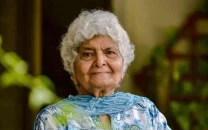



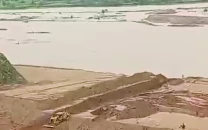

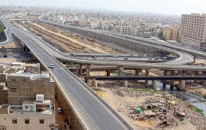






COMMENTS
Comments are moderated and generally will be posted if they are on-topic and not abusive.
For more information, please see our Comments FAQ